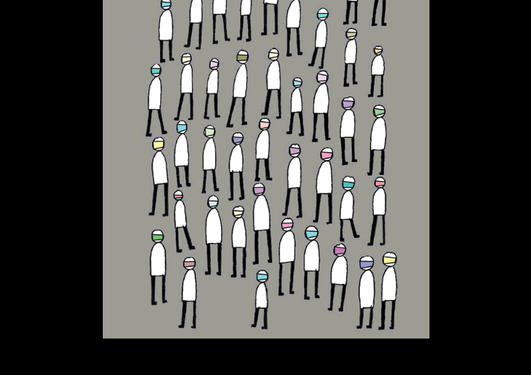Digital Art During the Pandemic Debuts Online
The new documentary provides a unique lens on the collective experience of the pandemic and is now available for open access screening online.

Main content
COVID E-LIT: Digital Art During the Pandemic follows sixteen digital artists’ experiences of the early COVID-19 pandemic throughout the United States, South America, and Europe. Through interviews with each artist, the documentary explores how measures taken to control the pandemic affected their artistic practice, ability to engage collaborators and audiences, daily life, and – most crucially – the subjects of the art they produced. It invites viewers to draw parallels between their experiences of the pandemic and those of the artists, while immersing them in the artworks that are the film’s focus.
COVID E-LIT: Digital Art During the Pandemic Promo
Covid E-Lit: Digital Art During the Pandemic is a documentary film by Anna Nacher, Søren Pold, Scott Rettberg, and Ashleigh Steele based on interviews with digital authors and artists who produced works reflective of the conditions of life during the 2020-2021 pandemic.
HOW PANDEMIC CHANGED PERFORMANCE HABITS
The pieces featured in the documentary range from visceral expressions of the anxiety brought on by the disease’s volatility (Pandemic Encounter; COVID-19 Soundpoem) to the products of day-to-day rituals done to bring routine and spark reflection at a moment that challenged these (I Got Up 2020: Pandemic Edition; Lost Inside Journal). They testify to how the pandemic changed long-standing projects and performance habits (Avenue S, Ghost City; QuarantineArtTV) and exacerbated issues endemic to already-ailing social and political institutions (EXPOSED; Coronário/Coronary).
They feature performances that dramatize the body’s problematic relationship to digital infrastructures (Room #3; The Tenders) and exaggerate the aspects of those infrastructures that hijack human vulnerability (The Endless Doomscroller; Content Moderator Sim). Alongside stark representations of loss (Infinite Catalog of Crushed Dreams; U.S. Covid Deaths 9/11 Visualization) are fun, whimsical responses to the constraints of isolation and lockdown (Coronation; The British Library Simulator) – a testament to just how diverse our experiences of the COVID-19 pandemic were and continue to be.
TOUCHES EACH INDIVIDUAL LIFE
“When we began discussing the COVID-19 pandemic and its potential impact upon digital art and electronic literature, we were struck by how few public memorials there are for victims of epidemics and mass disease,” said producer Søren Bro Pold.
As he and his co-producers observe in a chapter in a forthcoming book on culture during to pandemic to be published by Humanities in the European Research Area (HERA), this pandemic – like one of its most recent predecessors, the Spanish Flu – runs the risk of “not [being] sufficiently imagined” due to the many other crises with which it has coincided and which have contributed to its severity, among them climate change, widespread political corruption, and persistent socioeconomic inequality (particularly due to racism). It is, in Timothy Morton’s words, a “hyperobject” – something that touches each individual life but that is, due to its scope, complexity, and multifaceted interconnections with other issues, difficult to think. COVID E-LIT: Digital Art During the Pandemic aims to help viewers do just that by memorializing digital artists’ variegated experiences of its impact.
A UNIQUE LENSE TO COLLECTIVE EXPERIENCES
“We’re planning to show the documentary at film festivals, literary festivals, and conferences over the course of the next year or so, but also we felt it important to make it open access now, so that for instance people can use it in their teaching” said co-producer and Digital Culture professor Scott Rettberg. “It provides a unique lens on our collective experience of the pandemic through digital art and literature. The COVID E-Lit project is a great example of the type of work we hope to do as we develop the Center for Digital Narrative.” The University of Bergen’s proposal for a Center for Digital Narrative is a finalist for the SFF-V Norwegian Center of Research Excellence, to be determined in Autumn 2022.
The film brings together interview clips with recordings of digital artworks as these might be played, performed, or navigated. Its cinematography is a testament to how these interviews were conducted: We see the artist in their home or office addressing their interviewer through webcam, as if it is we, the audience, that is on the other side of these Zoom calls, with all the pixelation and audio delay/distortion that sometimes entails.
Each artist is introduced by a short clip from one of the interviewers meditating upon or asking about a salient moment from their conversation. Sometimes we see the artist testify to their experience as the interviewer would have, straight into the camera; at others, soundbites from their interview overlay snippets from their artworks.
ELECTRONIC LITERATURE AND COVID-19
Interviews were conducted by Anna Nacher, Søren Bro Pold, and Scott Rettberg approximately one year after the start of the pandemic during March and April of 2021. They were semi-structured, 45 - 60-minute back-and-forths addressing questions that had been developed through online discussions, questionnaire responses, and a conference roundtable at the beginning of the pandemic, when organization for the ELO 2021 conference was underway. This led to the DARIAH EU-funded project, “Electronic Literature and COVID-19,” as well as a dedicated exhibition for artworks about this topic at ELO 2021’s art festival. Ashleigh Steele created short, self-contained films from the initial interviews using Adobe Premiere Pro, which were further refined and re-arranged in collaboration with the rest of the production team.
All of the documentary’s works formed part of the Electronic Literature Organization: Platform (Post?) Pandemic Conference and Festival’s (ELO 2021) exhibitions, available here in the Covid and Performances sections. A dedicated research collection can be found on ELMCIP here.
The film was previewed at the University of Bergen, Norway, and at the 2021 Oslo International Poetry Festival. Several libraries have included it in their collections, among them the Roskilde Library in Denmark, the Bergen Library in Norway, and the British Library.
